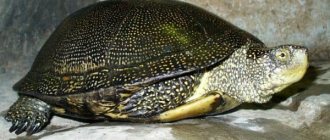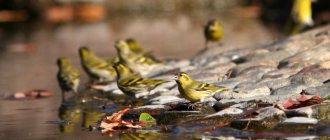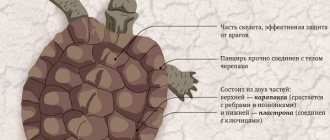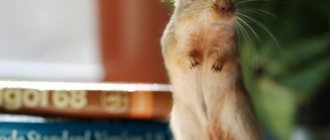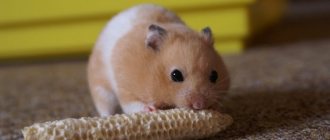Rodents are the richest order of mammals in terms of species diversity. Their characteristic feature is large incisors on the upper and lower jaws. The way of life, the functions performed by various parts of the body, and habitats determine the appearance of the various representatives of this order. The mass of rodents can range from five grams to several tens of kilograms.
Mammals of this order are found throughout the world. Where they did not exist, rodents were brought in specifically for various purposes. The only exceptions are the Antarctic region and some islands.
Family Gilts
Gilts live exclusively in South America in its most diverse climatic zones.
Representatives of this family have an elongated body, four-toed forelimbs and three-toed hind limbs, a short tail and neck, and a large head. Ears may be short, long, or absent altogether. The hairline is usually rough. The fur on the back is brown, gray, black or olive. The belly is light: color from white to dark yellow. Some species are nocturnal, others diurnal. However, none of them hibernate.
The family consists of 5 genera, which are represented by 15 species.
Abyssinian guinea pig
Peruvian guinea pig
Brazilian pig
Guinea pig
Mongolian gerbil
Gerbils are very active and social animals and are happy in a same-sex pair or small group. It is best to purchase them when they are young for easier joining.
With regular handling, gerbils can become quite tame. But their high energy levels can make them difficult to retain.
View overview
LENGTH : 10 cm
WEIGHT : 56 g
PHYSICAL CHARACTERISTICS : Mix of grey, gold and black fur; dirty white belly; long fluffy tail
Squirrel family
The family is divided into 5 subfamilies containing approximately 230 species. The most famous are the squirrel and the gopher.
Rodents of this family are widespread on all continents with the exception of Australia and Antarctica. A number of Arctic and tropical islands are also not inhabited by Squirrels.
These rodents can be small or large. Body length varies between 6-70 cm. Weight ranges from a few grams to 9 kg. All have a long tail covered with fur. Squirrels have strong, developed limbs and large eyes. The hair color can have stripes, spots or be one color: red, black, white, etc.
Chipmunk squirrel
prairie dog
Magellan tuco-tuco
Little chipmunk
Little gopher
Palm squirrel
Content
- 1 Origin
- 2 Taxonomy
- 3 General description 3.1 Structure of the skull
- 3.2 Teeth
- 3.3 Limbs
- 3.4 Cheek pouches
- 3.5 Digestive system
- 3.6 Brain
- 3.7 Reproductive system
- 4.1 Power
Family Hedgehogs
The species composition of this family is not the largest. However, 24 different species are known.
All Ezhovs have a number of characteristics that unite them into one family. These include a pointed, elongated muzzle, well-developed eyes and ears, and limbs with five fingers. A distinctive feature of the family is the skin with many needles interspersed with hairs of wool. These rodents also have a special muscle that runs through their entire body. She helps the animal curl up into a ball, escaping from predators.
The habitat of hedgehogs is Central and South Asia, Europe. They were once introduced to islands near Africa, where they spread safely.
Hedgehog
Mouse-like hamster
Mouse-like hamster.
The mouse-like rodent can live in rock crevices in the wild. When jumping, it reaches 30 cm from the ground when it senses danger. Small groups gather in one nest, where they hide from the cold and predators.
The diet consists of seeds, flowers, leaves, animal feed, insects, and carrion. In captivity, they are able to reproduce at any time of the year, in nature from March to December. Life expectancy is more than 9 years at home, in the natural environment about 2 years.
Family Mole rats
Mole rats are burrowing animals that are adapted to life underground. The family is divided into three subfamilies, which include more than 30 species of rodents.
Characteristic features of animals of this family are half-blind eyes, underdeveloped ears, short thick fur, and short limbs. The length of the body of various species can be from 0.13 to 0.48 m, and weigh from 100 g to 4 kg. Some species have powerful incisors with which they dig the ground. Other rodents use their front paws for this.
Mole rats live in Europe, Asia, and northeast Africa. They are also found on Russian territory.
Small bamboo rat
Lesser mole rat
Degu (Chilean squirrel, bush rat)
Relatively large rodents with a body length of 9 to 12 cm, of which about 7-9 cm “goes” to the tail. These are very social animals that get along well with each other, but it is still not recommended to breed them in large groups, since the rodent needs a lot of space for full development. The best option is to house a couple of degus of the same sex - this way the pets won’t get bored, and you won’t have to look for owners for numerous offspring.
Unlike guinea pigs, degus do not like to be treated freely and can bite strongly, therefore, when choosing a rodent for a family with small children, you should give preference to a more peaceful and phlegmatic animal.
If you have long wanted to have a pet, but doubt that you will be able to pay enough attention to it, start with a rodent. So, within a few months after purchasing the animal, you will understand whether your lifestyle allows you to take responsibility for a more “demanding” pet.
Family Jerboa
These rodents live in desert, semi-desert, steppe, and low mountain areas. They inhabited northern Africa, some parts of Europe, Asia, Kazakhstan, southern Siberia, etc.
These mammals have a short body, elongated hind legs, and short forelimbs, with which they remove the earth dug out with their incisors. The size of these rodents is 4-25 cm, weight no more than 300 g. All species have a very long tail, which serves as a rudder and balancer when running. These animals have a short neck, a large head, long rounded ears and a uniform skin of beige-brown shades.
Jerboas, with rare exceptions, are nocturnal. They dig burrows, feed on plants and insects, and bear offspring one to three times a year.
Small jerboa
Desert jerboa
Classification
Rodents are classified in the following taxonomic hierarchy:
- Domain: Eukaryotes;
- Kingdom: Animals;
- Phylum: Chordata;
- Class: Mammals;
- Order: Rodents.
Scientists agree on the definitions of most families, but they have historically disagreed about organizing families into larger groups, namely suborders. In early classifications, suborders were generally omitted, and families were grouped into superfamilies. The latest official classification identifies five suborders, whose representatives have similar features:
- Porcupines (Hystricomorpha): There are approximately 300 species of porcupine rodents living today. Members of this suborder include agoutis, porcupines, mole rats, nutrias, chinchillas, capybaras and many others. Hystricomorpha rodents have a unique arrangement of jaw muscles that sets them apart from other rodents.
- Myomorpha: There are about 1,400 species of living mouse-like rodents. This group includes mice, rats, hamsters, voles, lemmings, jerboas, muskrats, etc. Most species of mouse-like rodents are nocturnal; they feed on seeds and grains.
- Anomaluromorpha: has nine species, including the spiny-tailed squirrels, Pela's spiny-tails, long-eared spinytails, Cape striders, etc. Some members of this suborder (except the spiny-tailed squirrels) have flight membranes that allow them to glide.
- Squirrel-like rodents (Sciuromorpha): There are about 273 species of squirrel-like rodents. Members of this suborder include squirrels, chipmunks, marmots, flying squirrels, etc. Squirrels have a unique arrangement of jaw muscles that distinguishes them from all other rodents.
- Beavers (Castorimorpha) : has about 100 species from 3 families: beavers, gophers and pouchhoppers. This suborder was identified in 2005.
Family Gerbils
Gerbils are small rodents that look like mice. They can reach 20 cm in length depending on the species. Their weight ranges from 10 to 225 grams. These animals have a long tail, rather large eyes, and protruding ears. The color of their fur is unremarkable: the back is sandy or brown, and the belly is light.
The habitats of these rodents are desert, semi-desert, and steppe areas. They are widespread in Central Asia, Kazakhstan, and also in Africa. They are found in the smallest quantities in the Caspian region and Transbaikalia.
Gerbil Sundevalla
Sand mole rat
Agricultural pests
Rodents that feed on grain crops are serious pests, destroying both growing crops and already harvested crops. In Asia, rodents are one of the main factors limiting rice production. Separately, it should be noted the damage caused by rodents to books and other paper products.
The structure and appearance of rodents
The majority of rodents are relatively small in size. But among them there are small and large animals: from a dwarf mouse weighing 7 g and 3 cm long to a ninety-kilogram capybara, reaching up to 130 cm in length. Rodents usually have such a long tail that it can be twice or even three times as long as their body. But in many representatives of the Miguels this organ may be completely absent. Animals of this order can have different body shapes. It depends on what kind of life is inherent in a particular clan. For example, for those who have to move a lot from place to place, sometimes even jumping, the hind limbs in the process of evolution have become much longer than the front ones. This applies to Tushkanchikovs and Belichichs. Those who need to dig holes for shelter and search for food need strong front paws with powerful claws and a rounded body shape.
The anterior incisors in rodents are enlarged and separated from the chewing teeth by a diastema. They have the ability to self-sharpen. Rodents also have no fangs at all. The skeleton of mammals is represented by a spine with 30 main vertebrae and an individual number of tail vertebrae, four limbs, a massive skull, and large eye sockets. The number and size of bones depend on the specific representative.
The body of rodents is covered with hair, usually of equal length and not very striking colors. In some of them, the hairs have formed into needles (the Hedgehog family). On the front part of the animals there are vibrissae, which perform the function of touch.
[edit] General description
Most rodents are built quite proportionately. They have small paws and ears. They are long-tailed and covered with short, thick fur. Only forms that have developed special adaptations for protection from predators, obtaining food, or a specific way of life evade this type.
- Thus, underground inhabitants often have reduced eyes (mole rats).
- Inhabitants of open desert spaces run away from pursuit on very long hind legs (jerboas).
- In arboreal animals that are capable of gliding, a leathery fold hangs from the sides of the body, turning them in the air into a kind of small “parachute” (flying squirrel). Many rodents have hair that is turned into spines to protect themselves from predators, such as porcupines.
The appearance of rodents is quite diverse. Their sizes range from small (body length 5-6 cm in some mouse-like rodents) to medium (body length 130 cm in capybaras). The tail is very long (1.5-2 times longer than the body) to rudimentary.
The hair of rodents is usually thick and soft; spines often develop (porcupines, some mice). As an exception, hair may be almost absent (naked mole rats).
The upper lip of rodents is usually cleft to a greater or lesser extent.
[edit] Structure of the skull
Skull with a shortened brain section, an orbit open at the back, medium-sized or large (sometimes hypertrophied in desert rodents) auditory drums. The infraorbital foramen is small to hypertrophied. Its structure is of great taxonomic importance when distinguishing suborders: traditionally, sciouromorphic (minimum opening sizes), myomorphic and hystricomorphic (maximum sizes) types are distinguished.
There are two main types of mandible. This is also taken into account when developing the taxonomic system of the order (in the sciorognathic type the coronoid process is large, the angular process lies with it in the same plane; in the hystricognathous type the coronoid process is reduced, the angular process is displaced outward relative to the first).
[edit] Teeth
A distinctive feature of all rodents, without exception, associated with feeding on vegetation, is a pair of enlarged incisors in the upper and lower jaws. They are very long, constantly growing, and with their root part they penetrate far into the bones of the skull. Due to the fact that the enamel layer covers only the front surface of the incisors, when processing a hard surface it wears off more slowly than the back, so that the cutting edge always remains very sharp. In typical rodents, this pair of incisors is the only one; in lagomorphs, a second pair of rudimentary incisors is adjacent to the posterior edge of the main incisors, but it is not involved in gnawing. On this basis, by the way, lagomorphs are sometimes called bipaired incisors and are classified as a separate order.
The remaining teeth in rodents are located at a considerable distance from the incisors - this is generally characteristic of herbivorous mammals, including ungulates. Rodents do not have fangs, but the molars, located on the sides of the mouth, are approximately the same shape, with a flat chewing surface. They can crush seeds and “cut” grass, but cutting meat, much less crushing bones, is quite difficult.
Number of teeth from 12 to 22.
[edit] Limbs
The limbs are most often short, but in jumping desert forms (jerboas) the hind legs are greatly elongated. Fingers with claws, which in species leading an underground lifestyle are greatly enlarged. The auricle is absent in burrowing forms (mole rats, gophers) or greatly enlarged (some jerboas).
The collarbones are in most cases well developed, sometimes absent. The ulna and radius are often capable of rotational movement, which allows the front paws to bring food to the mouth.
The leg bones of some rodents are fused, while in others they are separate.
There are usually 5 toes on the front legs, but the internal parts are little or not developed at all. There are often five toes on the hind legs, even in cases where there are only four on the front legs. Sometimes the number of toes on the hind legs is reduced to three. In jerboas, which have three toes on their hind legs, the corresponding metatarsal bones are fused into one bone, similar to the long metatarsus of birds.
The fingers of rodents are armed at the ends with claws, sometimes flat nails. Almost all rodents are plantigrade.
[edit] Cheek pouches
Many rodents have cheek pouches. These are the lateral pouch-like projections of the walls of the oral cavity between the lips and jaws. In some rodents, instead of these internal cheek pouches, there are external ones that open on the outer surface of the cheeks, lined with hair and extending along the neck to the shoulder region.
Cheek pouches serve to collect food reserves.
[edit] Digestive system
1-Submandibular salivary glands;2-Liver;3-Small intestine;4-Larynx;5-Esophagus;6-Stomach;7-Spleen;8-Large intestine;9-Cecum The stomach of
rodents is simple, occasionally divided into cardiac and pyloric departments.
Due to feeding on rough plant foods, the intestinal tract of rodents is quite long. The intestine is 5-17 times longer than the body.
All rodents, except dormouse, have a cecum, in which food, in particular, is processed through fermentation.[2] The cecum is often wider than the large intestine and even the stomach, and is longer than the body.
The cecum is especially well developed in species that feed on grass and tree bark.
[edit] Brain
The cerebral hemispheres are devoid of convolutions (with the exception of only the largest of the rodents, the capybara). The cerebellum is not covered by the cerebrum and its middle part is more developed than the lateral parts.
[edit] Reproductive system
Some rodents have two completely separate uteruses. In others, both uteruses merge with each other only at their lower end and have one common vaginal opening.
The testicles (testicles) either remain in the abdominal cavity or are placed in the inguinal canal.
The placenta is disc-shaped, with a falling membrane.
There are from 2 to 14 nipples. They are located on the belly, and if there are a large number of them, on the chest.
Characteristics and features
Rodents appeared on the planet more than 60 million years ago and have evolved greatly since then. Some species developed and changed, others completely disappeared.
Representatives of the rodent order inhabit a wide variety of climatic zones, living in warm and cold, wet and dry places, near water bodies and deep in forests, on plains and in mountainous areas. They live on the ground, underground, in trees, in swamps. And some species have even mastered the airspace, for example, the flying squirrel.
Various rodents exhibit vital activity either at night and twilight, or during the daytime.
These mammals can exist in groups with different numbers of individuals or be solitary. Their brain is quite large in size and does not have convolutions on its surface. Rodents are quite smart animals, they can perform the simplest actions, they have their own language for communication.
Well-developed sensory organs responsible for tactile sensations, hearing and smell enable rodents to recognize danger in time and avoid it, communicate with their own kind, find food and everything necessary for existence.
Rodents have elongated intestines. This is due to the consumption of food mainly of plant origin.
Djungarian hamster
This is a cute, active and inquisitive pet. The animals are distinguished by their fertility. Among the disadvantages, it is worth noting the short lifespan. They live up to 4 years.
They are nocturnal and do not require special care. They are fed morning and evening. You can use food for small rodents or prepare a mixture of oats, corn, peas, seeds, and nuts.
You can add carrots, zucchini, cucumber, greens, lettuce, apple, pear, and berries to your diet. Sometimes you can treat them to boiled chicken, low-fat cottage cheese, and unsalted lard.
It is forbidden to feed:
- potatoes;
- sausages and sausages;
- mushrooms;
- onions, garlic;
- cabbage;
- watermelon;
- citrus fruits;
- chocolate;
- cookies;
- honey;
- sugar;
- salt and spices.
The natural color is expressed in a gray-brown back, which has a pronounced black stripe and a light belly. In nurseries, varieties with pearl, tangerine, and sapphire colors are bred.
Hamsters love edible sticks and spikelets. To grind teeth, it is appropriate to use a mineral stone or a birch block. Animals are kept in cages or aquariums. Place it in a quiet place where there is no exposure to direct sunlight or drafts.
Djungarian hamsters.
Rodent nutrition
The basis of nutrition of these mammals is plant food. They eat leaves, shoots, seeds, berries, gnaw twigs, bark, etc. But not all rodents are only herbivores. There are also omnivores among them, who, along with roots and herbs, eat insects, snails, worms, bird eggs, and small vertebrates (for example, lizards). Species living near water can feed on fish, shellfish and various crustaceans.
Animals spend a significant part of their lives getting food. Some representatives, mainly among Khomyakov, Squirrel and Mouse, store food for the winter in burrows and hollows.
The diet of rodents depends on the seasonality of the year. In summer, food is varied and includes seeds, plant parts, insects, etc. In autumn, berries, fruits and root vegetables. In winter, wood, bark and roots. In spring, the first young shoots and leaves begin to grow, which are necessary for the growth and development of the body.
The weather also affects the diet. In hot weather, rodents forage for food at night, when it is cooler. When daytime temperatures drop, they become active during daylight hours. Weather, age, and place in the hierarchy (for social species) also influence feeding behavior.
You can read what squirrels eat in the forest in winter and summer in a special article -
Natural enemies of mice and voles
Photo: Vole mouse
In nature, mice have a huge number of enemies that regulate their population. Mice are the favorite food of birds of prey. Owls, owls, eagles, hawks and other predators actively hunt mice. For example, in a year an adult owl can eat more than 1000 animals.
For many mammals (badger, wolf, fox, marten, weasel, ferret), mice are the main, often exclusive food. An adult ferret catches and eats up to 12 mice per day. The weasel is extremely dangerous for rodents, as it has a narrow body that can bend and penetrate mouse holes, destroying small cubs.
They enjoy eating voles and reptiles (snakes and large lizards), hedgehogs, and, of course, the most famous mouse hunter, the cat.
Reproduction of rodents
Animals of this order are very prolific. Females of small species can have several litters per year: from two to five. Moreover, each litter usually contains several cubs at once. The quantity varies from 5 to 15 pieces. And larger representatives of the order give birth once a year and no more than three cubs.
Some species give birth to underdeveloped young that require long-term care. And there are some animals that, after birth, are almost immediately ready to move independently.
Not only the number of annual litters varies greatly among species, but also the duration of pregnancy. In small animals it is short - only 18-20 days. And the larger the animal, the longer the pregnancy lasts. Muskrats, for example, remain in position for about 30 days, and nutria and capybaras for more than four months.
The population size depends on many environmental factors. In conditions of lack of food, it decreases, and vice versa. When the population increases excessively, some animals are even forced to migrate from their homes in search of new habitats.
Chinchilla
Chinchillas are active animals, which means that they need spacious and, preferably, multi-level cages where the rodent can freely perform its “acrobatic studies”. Separately, it is worth mentioning the care of your pet’s fur. A chinchilla should be given a so-called dust bath several times a week. To do this, sand is poured into a relatively deep container, for example, a deep cat litter box, or better yet, a special powder in which the animal falls out, cleaning itself.
Young chinchillas very quickly get used to a person, but not so much as to allow him to constantly carry them in his arms. He is unlikely to make a companion animal.
The importance of rodents in human life
The importance of rodents in human life is enormous. Some of them are a source of valuable furs, for example, the muskrat. Others are hunted for their meat and fat. Experiments are carried out on laboratory rodents to study diseases, drugs and other chemicals.
Rodents carry plant seeds, and underground inhabitants also loosen the soil, enriching it with oxygen and allowing water to better penetrate into the ground. They are hunted by predatory mammals. All this ultimately benefits the person.
Rodents also cause significant harm. They are carriers of various bacterial and viral infections, parasites and fungi. Rodents also cause harm to agriculture and households by eating, contaminating food and spoiling things. Therefore, in order to protect himself and his property, people regulate the number of synanthropes using traps and pesticides.
Representatives of the rodent order adapt well to changes in external living conditions. This makes it possible to tame them. Some species have long become familiar domestic animals. People keep some types of rats, guinea pigs, hamsters and others.
Rodents are an intermediate component of food chains that transform the biological mass of plants and animals. Their irrational destruction harms natural ecosystems. Therefore, they, as part of nature, suffering from the consequences of human activity, need to be preserved and protected.
Disease carriers
Rodents living in close proximity to humans, whether pets or wild animals, are carriers of diseases. For example, rodents are traditional sources of listeria infection. In addition, proteins in the urine or blood serum of rodents can cause allergies. Chipmunks are natural carriers of at least 8 pathogens of dangerous diseases, such as tick-borne encephalitis, rickettsiosis, toxoplasmosis, etc. Marmots are natural carriers of bubonic plague.
Habitat
Throughout Russia, Ukraine, Belarus, China, Europe and other countries. They can also be found in China, Mongolia, Denmark, Finland, Korea, and Taiwan. In the Russian Federation, the rodent is distributed in Primorye, Siberia, and the Urals. Prefers hills and mountains. Found near the Black and Azov Seas.
Does not like deserted forest-steppes and continuous forests. It takes root well in moist interfluves. Prefers overgrown meadows, small depressions, collective farm fields, sunny edges of deciduous forests and vegetable gardens. It can be found in greenhouses, greenhouses, cellars, abandoned utility sheds and even in residential premises. With the onset of autumn, rodents move into stacks, haystacks, and stacks of straw.

